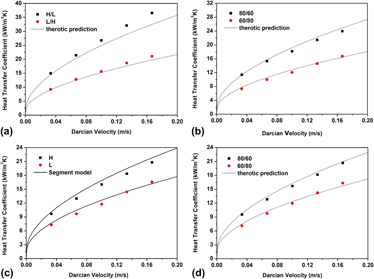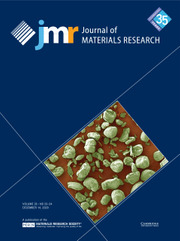Crossref Citations
This article has been cited by the following publications. This list is generated based on data provided by
Crossref.
Xiao, Z.
and
Zhao, Y.Y.
2014.
Thermal Properties of Porous Copper Manufactured by Lost Carbonate Sintering.
Materials Science Forum,
Vol. 783-786,
Issue. ,
p.
1603.
Carpenter, Katherine P.
and
da Silva, Alexandre K.
2014.
A combined hydro-thermal characterization of high-porosity metal foam test sections with discrete pore-size gradients.
International Journal of Heat and Mass Transfer,
Vol. 77,
Issue. ,
p.
770.
Diao, K.K.
Xiao, Z.
and
Zhao, Y.Y.
2015.
Specific surface areas of porous Cu manufactured by Lost Carbonate Sintering: Measurements by quantitative stereology and cyclic voltammetry.
Materials Chemistry and Physics,
Vol. 162,
Issue. ,
p.
571.
Baloyo, Jan Mary
and
Zhao, Yuyuan
2015.
Heat Transfer Performance of Micro-Porous Copper Foams with Homogeneous and Hybrid Structures Manufactured by Lost Carbonate Sintering.
MRS Proceedings,
Vol. 1779,
Issue. ,
p.
39.
Massoni, Nicolas
2016.
Study of a nickel-copper filter for the future conditioning of insoluble residues.
Journal of Nuclear Materials,
Vol. 479,
Issue. ,
p.
365.
Benmerkhi, M.
Afrid, M.
and
Groulx, D.
2016.
Thermally developing forced convection in a metal foam-filled elliptic annulus.
International Journal of Heat and Mass Transfer,
Vol. 97,
Issue. ,
p.
253.
Gauna, Edgar Avalos
and
Zhao, Yuyuan
2017.
Numerical Simulation of Heat Transfer in Porous Metals for Cooling Applications.
Metallurgical and Materials Transactions B,
Vol. 48,
Issue. 4,
p.
1925.
Zhu, Pengcheng
and
Zhao, Yuyuan
2017.
Mass Transfer Performance of Porous Nickel Manufactured by Lost Carbonate Sintering Process.
Advanced Engineering Materials,
Vol. 19,
Issue. 12,
Baloyo, J. M.
2017.
Open-cell porous metals for thermal management applications: fluid flow and heat transfer.
Materials Science and Technology,
Vol. 33,
Issue. 3,
p.
265.
Diao, Kaikan
Zhang, Liping
and
Zhao, Yuyuan
2017.
Measurement of tortuosity of porous Cu using a diffusion diaphragm cell.
Measurement,
Vol. 110,
Issue. ,
p.
335.
Baloyo, J. M.
2017.
Open-cell porous metals for thermal management applications: fluid flow and heat transfer.
Materials Science and Technology,
Vol. 33,
Issue. 3,
p.
265.
Chirilă, Adina
and
Marin, Marin
2018.
The theory of generalized thermoelasticity with fractional order strain for dipolar materials with double porosity.
Journal of Materials Science,
Vol. 53,
Issue. 5,
p.
3470.
Diao, Kai Kan
Lu, Xian Ke
Wu, Zhi Ning
and
Zhao, Yu Yuan
2018.
Heat Transfer Performance of LCS Porous Copper with Different Structural Characteristics.
Materials Science Forum,
Vol. 933,
Issue. ,
p.
380.
Diao, Kaikan
and
Zhao, Yuyuan
2019.
Heat transfer performance of sintered Cu microchannels produced by a novel method.
International Journal of Heat and Mass Transfer,
Vol. 139,
Issue. ,
p.
537.
Zhu, Pengcheng
Wu, Zhining
and
Zhao, Yuyuan
2019.
Hierarchical porous Cu with high surface area and fluid permeability.
Scripta Materialia,
Vol. 172,
Issue. ,
p.
119.
Lu, Xianke
and
Zhao, Yuyuan
2019.
Effect of flow regime on convective heat transfer in porous copper manufactured by lost carbonate sintering.
International Journal of Heat and Fluid Flow,
Vol. 80,
Issue. ,
p.
108482.
Mohammed, Hayder I.
sardari, Pouyan T.
and
Giddings, Donald
2019.
Multiphase flow and boiling heat transfer modelling of nanofluids in horizontal tubes embedded in a metal foam.
International Journal of Thermal Sciences,
Vol. 146,
Issue. ,
p.
106099.
Lu, Xianke
2020.
Fluid Flow and Heat Transfer in Porous Media Manufactured by a Space Holder Method.
p.
7.
Mosalagae, Mosalagae
Brambila Renteria, Carlos M.
Elbadawi, Mohammed
Shbeh, Mohammed
and
Goodall, Russell
2020.
Structural characterisation of porous copper sheets fabricated by lost carbonate sintering applied to tape casting.
Materials Characterization,
Vol. 159,
Issue. ,
p.
110009.
Lu, Xianke
2020.
Fluid Flow and Heat Transfer in Porous Media Manufactured by a Space Holder Method.
p.
1.


